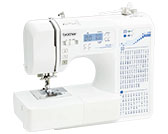FS101
FAQs & Troubleshooting |
Fabric is caught in the machine and cannot be removed
If the fabric is caught in the sewing machine and cannot be removed, the thread may have become tangled under the needle plate. Follow the procedure described below to remove the fabric from the machine.
If the operation could not be completed according to the procedure, instead of attempting to complete it forcefully, contact your nearest authorized service center.
Removing the fabric from the machine
-
Immediately stop the sewing machine.
-
Turn off the sewing machine.
-
Remove the needle.
Refer to How do I change the needle?
If the needle is lowered into the fabric, turn the handwheel away from you (clockwise) to raise the needle out of the fabric, and then remove the needle.
-
Remove the presser foot and presser foot holder.
Refer to How do I remove or attach the presser foot? and How do I remove and attach the presser foot holder? -
Lift up the fabric and cut the threads below it.
If the fabric can be removed, remove it. Continue with the following steps to clean the race. -
Remove the needle plate cover.
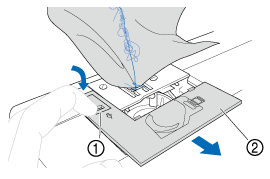
(1) Needle plate cover release
(2) Needle plate cover
-
Cut out the tangled threads, and then remove the bobbin.
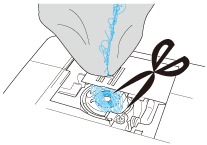
-
Remove the bobbin case.
If threads remain in the bobbin case, remove them.
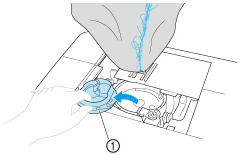
(1) Bobbin case
-
Use the cleaning brush or a vacuum cleaner to remove any dust from the race and its surrounding area.

(1) Cleaning brush
(2) Race
> If the fabric could be removed, continue with step 17.
> If the fabric could not be removed, continue with step 10. -
Use the enclosed disc-shaped screwdriver to loosen the two screws on the needle plate.
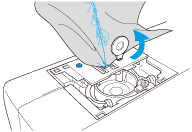
Be careful not to drop the removed screws in the machine.
-
Slightly lift up the needle plate, cut any tangled threads, and then remove the needle plate.
Remove the fabric and threads from the needle plate.
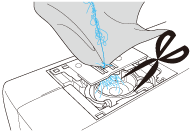
If the fabric cannot be removed, even after completing these steps, contact your nearest authorized service center.
-
Remove any threads in the race and around the feed dogs.
-
Turn the handwheel to raise the feed dogs.
-
Align the two screw holes in the needle plate with the two holes at the needle plate mounting base, and then fit the needle plate onto the machine.
-
Lightly finger-tighten the screw on the right side of the needle plate. Then, use the disc-shaped screwdriver to firmly tighten the screw on the left side. Finally, firmly tighten the screw on the right side.
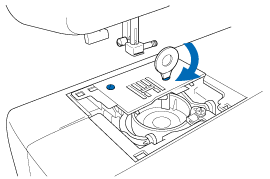
-
Turn the handwheel to check that the feed dogs move smoothly and do not contact the edges of the slots in the needle plate.
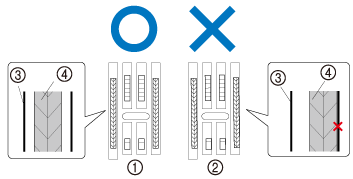
(1) Correct position of feed dogs
(2) Incorrect position of feed dogs
(3) Needle plate
(4) Feed dogs
-
Insert the bobbin case so that the
 mark on the bobbin case aligns with the
mark on the bobbin case aligns with the  mark on machine as shown below.
mark on machine as shown below.
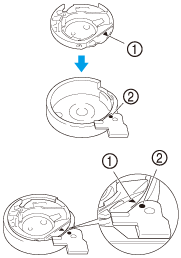
Align the
 and
and  marks.
marks.
(1)
 mark
mark(2)
 mark
mark(3) Bobbin case
Make sure that the indicated points are aligned before installing the bobbin case.
- Never use a bobbin case that is scratched, otherwise the upper thread may become tangled, the needle may break or sewing performance may suffer. For a new bobbin case (part code: XE7560-001), contact your nearest authorized service center.
- Make sure that you fit the bobbin case properly, otherwise the needle may break.
-
As shown, insert the tab on the needle plate cover into the hole in the needle plate, and then correctly position of the needle plate cover.
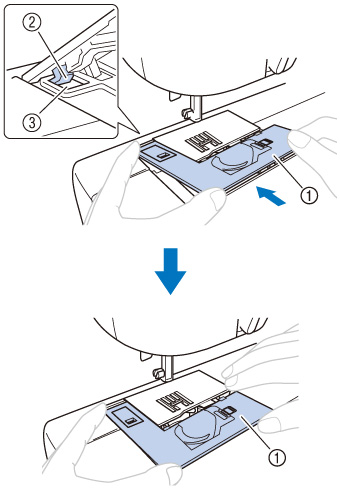
(1) Needle plate cover
(2) Tab(3) Hole
Check that the needle plate cover is flush with the top surface of the machine.
-
From the front, slide the needle plate cover back into position.
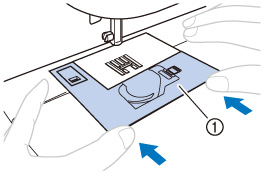
(1) Needle plate cover
If the needle plate cover is not flush with the surface of the machine as shown below, remove the needle plate cover, and then install it again.
Sewing while the needle plate cover is not flush with the surface of the machine may cause the needle plate cover to come off of the machine, resulting in injuries if your fingers touch the race.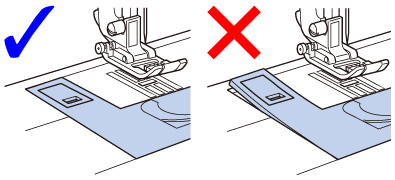
-
Check the condition of the needle, and then install it.
If the needle is in a poor condition, for example, if it is bent, be sure to install a new needle.
Before using the needle, place the flat side of the needle on a flat surface and check that the distance between the needle and the flat surface is even.

(1) Flat side
(2) Needle type marking
Correct needle

(1) Flat surface
Incorrect needle
If the distance between the needle and the flat surface is not even, the needle is bent. Do not use a bent needle.

(1) Flat surface
Do not use a bent needle. Sewing with a bent needle is extremely dangerous since the needle may break while the machine is being operated.
Checking machine operations
If the needle plate has been removed, check machine operations to confirm that installation has been completed correctly.
-
Turn on the machine.
-
Select
 (middle needle position stitch).
(middle needle position stitch).
Do not yet install the presser foot and thread.
-
Slowly turn the handwheel toward you (counterclockwise), and look from all sides to check that the needle falls at the center of the hole in the needle plate.
If the needle contacts the needle plate, remove the needle plate, and then install it again.
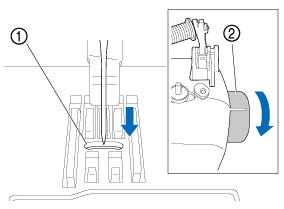
(1) Hole in the needle plate
(2) Handwheel
-
Select
 (zigzag stitch) . At this time, increase the stitch length and width to their maximum settings.
(zigzag stitch) . At this time, increase the stitch length and width to their maximum settings.
-
Slowly turn the handwheel toward you (counterclockwise) and check that the needle bar and feed dogs operate correctly.
If the needle or feed dogs contact the needle plate, the machine may be malfunctioning; therefore, contact your nearest authorized service center. -
Turn off the machine, and then install the presser foot holder and presser foot.
Refer to How do I remove or attach the presser foot holder? and How do I remove or attach the presser foot? -
Install the bobbin.
Refer to How do I install the bobbin wound with thread? -
Correctly thread the machine.
Refer to How do I thread my machine?The thread may have become tangled as a result of incorrect upper threading. Make sure that the machine is correctly threaded.
-
Perform trial sewing with normal fabric.
Incorrect sewing may be the result of incorrect upper threading or sewing thin fabrics. If there are poor results from the trial sewing, check the upper threading or the type of fabric being used.
